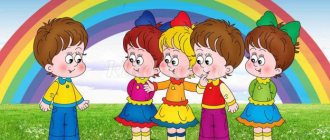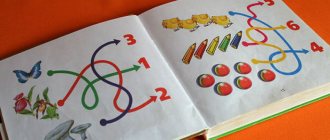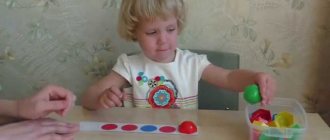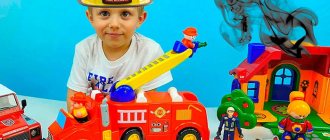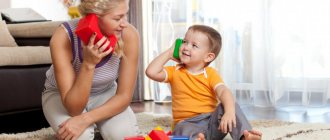Children love playing with sand and water, and in hot weather you can add experiments with ice. Here are a few activities that Asya Vanyakina, a passionate mother and famous blogger, came up with for her son and described in the book “Iceberg on the Carpet.”
The first time I froze small ice cubes for Osya was when he was not yet a year and a half old. We put the finished pieces of ice in a cup of water, and Osya tried to grab the slippery pieces of ice, but they jumped out of his hands and scattered around the room. At that moment, I realized that now I would have to remember to freeze the water in the evening.
How often in the evenings, when I didn’t feel like playing at all, and Osya was still full of energy and ideas “what to create for the night,” ice cubes and ice blocks with toys frozen in them, forgotten in the refrigerator, saved us. What could be easier than spending five minutes, while we are already busy in the kitchen, and putting water in the freezer - different colors, in different shapes, with different small toys that are always lying under our feet. And then someday, take out the ice and say joyfully: “Look what we have!”
Ice Excavations
Invite your child to rescue his toys from a large block of ice. For this game, first select suitable items - small cars, parts of various construction sets, animal figures, and then freeze them in a large form.
You will need:
- large bowl
- small children's toys
- boiled water
- tools for removing toys - a children's hammer, a spoon and everything that comes to the child's mind
You will have to freeze the ice for this game in several stages.
- Place the figures on the bottom, fill the bowl with water about a third.
- When the water freezes, lay out the new toys and fill them with cold boiled water again. This way the figures will be distributed in layers and not accumulate at the bottom.
- At the last stage, you can add water so that parts of the figures remain above the water. This way the children will immediately understand the meaning of the game. My son likes it when the water in the uppermost level does not freeze completely, then playing with the block turns out to be more dynamic - the upper level of ice breaks faster, and it is easy for the child to release the first figures.
- When the ice is frozen enough, place the bowl of it under cold water. Flip it over and the ice will slide out easily.
- Place the block on a tray or in a basin and you can start playing.
Games with ice: 6 tips To keep the ice clear, you need to freeze boiled water at room temperature. It is better not to freeze anything in a glass container, it will certainly burst. Your refrigerator can become damaged if you freeze too much ice at once. Before letting children play with ice, rinse it with cold water to prevent it from freezing to their fingers. Some children may not like the fact that their hands are wet and cold. Prepare a towel in advance so you can warm and dry your hands. And place a bowl of warm water nearby. Children may also just like to chew on ice. As with any game, especially ice games, preparation for the game can take longer than the game itself. But it's worth it.
And fire, and water, and ice - be careful!
Then we begin to heat the upper part of the test tube on the flame of an alcohol burner - just its upper part. After a very short period of time, the water boils and steam is released from the test tube. But why doesn’t the ice lying at the bottom melt, what a miracle of nature?
The trick is that boiling water is only in the upper part of the test tube, and at the bottom it remains cold, that is, our ice is not “in boiling water”, but “under boiling water”. As you know, under the influence of heat, water tends to expand and become lighter, so boiling water does not even think of sinking to the bottom and mixing with cold water. There is no interaction between the upper hot and lower cold layers; the lower part of the test tube can heat up only by thermal conductivity, but, as is known, this indicator for water is not too high.
By the way, the simplest experiments with ice and snow, understandable even to a tiny child, are watching flying snowflakes on the street. If you take a sheet of black velvet paper and go out into the yard in the snow, the falling snowflakes on the sheet will demonstrate their impeccable crystalline structure. After standing a little longer, we will get a clear idea of how the snow pattern is formed.
Dinosaur eggs
You can diversify the game with ice by freezing, for example, dinosaurs inside balloons. You will get ice eggs with dinosaurs inside. You can play with ice eggs, how dinosaurs hatch in our time, how they get along with modern animals. You can take a bath with them and watch how the ice balls quickly melt.
You will need:
- several regular balloons
- small dinosaur figurines
- water
- Stretch the narrow part of the balloon as far as possible so that the dinosaur can crawl deep into the balloon. Carefully place the figurine there. Some dinosaurs will easily fit inside the ball, while others may have too long necks or tails. Don't try to force them into the ball, it's better to start pouring water carefully, and then the ball will stretch.
- Gently pull the balloon onto the water faucet and hold it tightly with your fingers so that it does not fall off.
- Now carefully turn on the water in a thin stream and watch how the ball begins to grow before your eyes. It is better to additionally support the ball from below so that it does not tear. You don't want to add too much water, especially if you want to freeze your dinosaur eggs in the freezer rather than outside in the winter.
- Turn off the water, carefully remove the ball from the tap and tie it in a knot. Now you need to place the ball in the freezer, after placing it on a plate or tray.
- To ensure the eggs are frozen whole, leave them in the freezer overnight.
- The next day, remove the frozen balls from the refrigerator and remove the shell. You can start playing: defrost the ice under warm water, hit it with a hammer, sprinkle salt, just leave it to melt in the sun - any method will do.
- To make the wait less boring, prepare with your child a place where the dinosaurs will live after hatching.
- Once the dinosaurs hatch, you can send them to the prehistoric world and let them do normal dinosaur things.
Advertising
Are experiments necessary for preschoolers?
What patterns can a kindergarten child understand? We can talk quite confidently about the different states of substances, their transition to other qualities, the characteristics of air, the ability of sand to pass water, and the like.
Experiments for preschoolers help sharpen logical thinking, ability to make comparisons and make correct conclusions. Children learn to formulate their own opinions and defend them.
Each of them should be based on the ideas that the child had at the time the experiment began. Moreover, children should take an active part in the process. When discussing the results with them, preschoolers should be encouraged to express independent judgments. Thanks to simple experiments, children can be introduced to a considerable number of characteristics of water, clay, sand, etc.
As an example, let's look at experiments with ice for kindergarten children, explaining the properties of water, as well as its other well-known state - ice. It would seem that water is a long-familiar and familiar substance to everyone, but how much unknown a child can learn in the course of a well-prepared experiment!
Ice sled slide
Try freezing some ice cubes with small animals or Lego figures in them.
You will need:
- Form for ice
- small figurines of animals or people
- water
- First, freeze a small amount of water in an ice tray.
- When ice forms there, place the figure on it, add water and return the form to the freezer.
- When everything is ready, you can arrange a competition to see whose figurine can roll down the slide the fastest. Before the game begins, pour cold water over the cubes to make them smooth, and you can begin the competition.
For us, the role of a slide was played by an unnecessary polished board. You shouldn’t make the hill steep; on the contrary, it’s more interesting to compete on a flat one - the figures will slow down, and then suddenly go faster and faster, so it’s impossible to predict the outcome of the race.
Advertising
Snow flowers
Experiment number 3. For this, prepare a soap solution and a straw. By the time the experiment begins, children should already know that snowflakes are microscopic crystals, the formation of which occurs in clouds in cold weather. The purpose of our experience will be precisely to see how this happens.
To carry it out, you need to leave the room on a clear, frosty day (the air temperature should be quite low). Almost all experiments with ice or snow outdoors require cold weather - nothing will work during a thaw.
Try blowing a large soap bubble through a straw. Snow “flowers” will form under a thin layer of film and grow right before your eyes.
At the same time, it is worth demonstrating to children the process of frost formation. It’s even easier to do this - when it’s cold, we take a cup of boiling water with us outside and cover it with something metal, for example, a saucepan lid. Droplets of steam from boiling water will settle on it and quickly turn into frost crystals in the frosty air.
Ice Flotilla
An ice flotilla can be great fun. The main thing is to freeze many boats at once, because they melt so quickly!
You will need:
- Form for ice
- small piece of cardboard
- toothpicks
- foil
- basin or large bowl
- figurines of fish and other sea creatures
- water
- First you need to freeze ice cubes with small sticks or toothpicks, which will later become masts. To ensure that all the toothpicks freeze strictly vertically and are suitable for the role of ship masts, I first trace the ice mold on a small cardboard, and then stick the toothpicks into the cardboard, approximately falling into the center of each cell. Of course, sharp toothpicks are easier to stick into cardboard than, for example, matches or small sticks. Now you need to turn the cardboard over with the toothpicks down and place it over the mold so that each toothpick falls into its own cell. Place this entire structure in the freezer. When the water freezes, you can easily remove the cardboard and the toothpicks will remain in the ice.
- Now attach small sails, and you can launch ice boats in a basin or bathtub. I usually make sails from foil, they don’t get wet in water, and they don’t need to be specially glued to toothpicks. For flag sails, cut small strips of foil 1.5 cm wide and 3–4 cm long. At one end of the strip you can cut a triangular or any other shaped flag, and wrap the other end around a toothpick several times. If it's summer, you can make sails from different leaves or flower petals.
- The game of boats will not last long - 10-15 minutes. You can blow on the sails and see which boat will sail faster or go to the bottom first. You can pretend to attack a fleet of giant crabs - or any other sea animal you find around the house. And if you want, arrange a naval battle, and at the same time an accuracy competition: take aim and throw coins or small pebbles at the ships.
Try specially coloring the water in the basin to make playing more interesting. Or you can make only the boats different colors, and when they start to melt, watch how the water gradually turns colors.
Summary of GCD in the middle group for experimentation. Properties of snow
Summary of direct educational activities with children 4-5 years old on the implementation of the educational area “Cognitive Development” on the topic “Snow Cake”.
Author: Natalya Lvovna Stan, teacher of the MKDOU “Kindergarten No. 4”, Usolye, Perm Territory.
This material will be useful for educators when introducing children to the properties of snow and teaching them the ability to simulate experience.
Goal: To familiarize children with the properties of snow through experimental activities. Objectives: Educational: 1. Systematize ideas about snow and its properties: sticky, cold, wet, melts in heat, turning into water, through examination of the object and experimental activities. 2. Train children in the ability to model the sequence of an experiment through a sign system. 3.Teach children to experiment in the form of trying actions. 4. Activate children’s speech through cognitive questions. Developmental: 1. Promote the development of logical thinking through identifying cause-and-effect relationships and practical activities. (Develop in children the ability to observe, draw conclusions, put forward simple hypotheses with the help of the teacher, test them with the help of the teacher.) Educational: 1. Cultivate interest in the world around them through research activities. 2. Foster mutual assistance during experiments. Materials: Luntik toy, sensation box, bowl with snow, mold, spoon, spatula, tray, napkin. Scheme cards (modeling of experience). Musical accompaniment. Snowflakes. Preliminary work: Observing the snow on a walk, looking at snowflakes. Getting to know the properties of snow, playing snowballs. Progress: Introduction to the game situation: /2min./ Luntik comes to the group unnoticed by the children and begins to cry. /children are playing at this time/. The teacher asks, children, which of you is crying, what is wrong, what happened. The children begin to look at each other and report that none of them are crying, but the crying continues. Then the children and the teacher begin to walk around the group and look (search) who is crying. And they find Luntik crying. The children and the teacher ask Luntik: What happened? Why are you crying? Luntik: I prepared a treat for my friends Kuzi, Mila, and Bee: pies, cake, and put it on the table. And I went to invite friends to visit me, when we came to my house, the cake was no longer on the table. My friends thought that I had deceived them, were offended by me and left. And I’m so offended, I tried so hard, I prepared pies, a cake, but it disappeared somewhere! So I don’t know what to do! Difficulties in a game situation: /2min./ ? What happened to Luntik, why is he crying? (children say that the cake is missing)? Children, where do you think the cake went? (children make assumptions)? Children, what do we need to know to find the cake that Luntik prepared? (answers of children's assumptions) Educator: Children, let's ask Luntik what he made the cake from? (children ask) Discovery of new knowledge or methods of action: /4min/ Luntik: But this is my riddle for you! (a box of sensations is brought in) Children take turns lowering their hands and examining the “object” by touch, expressing an opinion about what might be there. The teacher asks : what did you feel, what object does it feel to the touch (cold, wet, maybe one of the children suggests that there is snow there) How to find out what exactly is there (look) The teacher opens the sensation box and takes out the snow. ? What is this? (snow) ? What does he look like? (children list) ? So what did Luntik make the cake from? (from snow) ? Children, can any of you guess why the cake disappeared? (answers of children's assumptions) Inclusion of new knowledge or method of action: ? Luntik: Why did it melt? (children say that the room is warm, that’s why the snow melted). Educator: How can we check whether the cake that Luntik made really melted? /make a cake yourself/ If the children do not make suggestions, the teacher offers to make a cake out of snow themselves. ? What items do we need to make a snow cake? /use a hand model/ - a bowl with snow, - a mold, - a spoon-shovel, - a tray, - a napkin. /Children independently prepare their own workplace/ The teacher offers the children reference cards-schemes for modeling the experiment: 1 card - take snow, put it in a mold 2 card - turn the mold over to make a cake 3 card - put it in a warm place (schematic representation of all cards) Children conduct an experiment , help each other as needed. While the children are performing the experiment: a winter melody sounds. Physical education /1 min./ 1,2,3 turn around and turn into a snowflake Snowflakes are falling from the sky, like in a fairy-tale picture. We'll catch them with our hands and show them at home to mom. And there are snowdrifts all around, the roads are covered with snow. Don’t get stuck in the field so that we raise our legs higher. Finger gymnastics “Snowball”. /1 min./ Let's show Luntik how we make snowballs out of snow. One, two, three, four bend the fingers, starting with the thumb
You and I made a snowball
, “sculpt” it, changing the position of the palms
Round, strong,
show a circle, squeeze the palms
Very smooth
together, stroke the other with one palm)
they threaten
not at all sweet finger. Let's throw them
up, look up, and throw an imaginary snowball.
Two, let's
catch them, squat down and catch an imaginary snowball.
Three-drops
get up and drop an imaginary snowball.
And... let's break
the stomp.
Luntik offers to see what happened to the pies. The children notice that the snow pies have melted and the conclusion is drawn: the snow melts in the warmth and water is obtained.
The prepared child reads P. Voronko’s poem “Pie.” Snow was falling on the threshold, the cat made a pie for himself. And while I was sculpting and baking, the pie flowed away like a stream. Bake your own pies, not from snow - from flour! Result: /3 min./ Tell me guys, did we help Luntik understand where his cake disappeared to? (yes) What happened to the pies and cakes that Luntik prepared? (melted) Why? (the room is warm) So what conclusion can we draw? (snow melts in the warmth and turns into water) Educator: Well, Luntik, now you know where your cake is, it has melted. Children, is it possible to eat snow? (no, why? (children's answers) Luntik thanks the children for their help in finding a snow cake and gives the children snowflakes of kindness Luntik : These are snowflakes of kindness, they will never melt for you, I give them to you so that you can play with them. Now I know where my cakes and pies went - they melted, I won’t make treats out of snow anymore. Thank you! It’s time for me to go see my friends, they’ve been waiting for me. Goodbye!
We recommend watching:
Experimental activities in kindergarten. Junior group Direct educational activity on experimentation in the middle group Integrated cognitive cycle lesson in the older group on the topic: Winter Summary of GCD in the middle group on the topic “Air” (with elements of entertainment)
Similar articles:
Summary of a drawing lesson in the middle group
Summary of a comprehensive lesson in the middle group “Spring in the Village”
Summary of GCD in the senior group on the topic “So that your teeth don’t hurt”
Summary of GCD in the middle group on the topic “Journey to the autumn forest”
Summary of GCD in the middle group on the topic: “So summer is over”
Let's paint the snow in different colors
Experiment number 5. We continue our experiments with snow and ice. This time you will have to stock up on a number of plastic bottles, into which you should pour hot water, and the water should be tinted with gouache in different colors. The cork in each bottle should be pierced with a needle, making a small hole.
In addition, you will need to take a children's shovel and find several surfaces in the kindergarten area that are covered with an even layer of snow.
The knowledge that children have at the start of the experiment is that everything (including snow and ice) consists of small particles called molecules. During the experiment, we will clearly demonstrate to children how various objects and substances are colored. And this happens due to the penetration of pigment into the structure of the object that we want to decorate.
When going for a walk after a snowfall, when the paths are covered with fresh fluffy snow, give the children a bottle of colored water, hot enough so that it does not immediately freeze. Look where exactly the snow lay in layers of different thicknesses.
Invite the children to make colored designs on its surface by splashing colored water. This activity in itself is very interesting. Perhaps kids who are carried away by the creative process will not want to discuss the scientific side of the experiment, but this is not scary. Having drawn themselves, they will return to studying the subject.
Offer to lift the snow with a shovel and draw the child’s attention to the fact that the thickness of the painted layer depends on the amount of water poured and the degree of fluffiness of the snowdrift. If we try to paint dense snowballs or a well-compacted surface, the colored water will not be able to penetrate deeper than the topmost layer. The result will be more evident the stronger the frost outside.
Ice experiments for children
- Ice skating rink and slide : Freeze a thin layer of colored water in a container, and freeze small toys with their feet in the ice in an egg tray. Take them on the skating rink and send them down the slide.
- Drawing with tinted ice cubes.
- Drawing on ice. We freeze a thin layer of water in a plastic container, put it out of the container (rinsing it with hot water), and the children draw with gouache and watercolors. Salt produces beautiful patterns and stains, the ice cracks and melts.
- Sun . Melting of colored ice in clear water. If you put ice in hot and cold water, you can see rainbow “rays” appear.
- Ice with a secret . Similar to the game Excavation at the beginning of the article. Color the water before freezing toys in it. The goal is to figure out what's hidden inside the ice cube before it completely melts.
- Effervescent figures . Mix soda with water (2-3 tablespoons of soda per 200 ml of water), place in molds, and freeze. Dissolve 2 tablespoons of citric acid in 200 ml of water and pour the laid out figures with a pipette or syringe without a needle, they hiss and foam beautifully.
- Task for those who are older. How to remove an ice cube from a glass of water using only a string without holding the ice with your hands? If you know the answer, write in the comments.
We get clean ice
Experiment number 6. Stock up on water (regular, salty and sweet). Start by telling the children that although they know ocean water is salty, the ice on the surface of the Arctic Ocean is fresh. During the experiment, together with the children, we will find out how freezing water occurs from impurities in the form of sugar and salt.
To conduct the experiment, prepare several ice cubes in advance. Carefully split each of them in half, obtained from sweet, salty, as well as the most common fresh water. Ask the children - do they think that if we freeze sweet or salty water, we will get the same ice?
Most likely, the answer will be yes. But this is wrong - in fact, the water that crystallizes during the formation of ice gets rid of foreign molecules and impurities. To confirm your words, allow the children to lick the ice pieces and make sure you are right.
